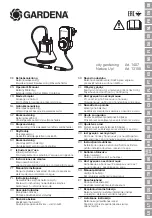
December 2020
3
Translation of original operating manual for anchorage points PLGWI-PSA pewag winner gamma inox
Material:
The duplex steel used for ring, screw
and sleeve has a high resistance to pitting corrosion,
crevice and stress corrosion cracking (PRE(N) value 34).
Operating temperature:
The long-term permitted ambient
temperature must be between -40 °C and +280 °C.
Impacts:
The anchorage point is designed to withstand
impacts and swinging expected in the event of a fall.
Other information:
The anchorage point may only be
mounted with original parts. The ring is 360° rotatable around
the screw and must be aligned with the expected direction of
pull prior to loading.
For exact dimensions, refer to our website at www.pewag.com
2.1 Restrictions on use
• The anchorage points are not suitable for edge- or corner-
loading.
• The anchorage points may not be rotated while under load.
• The hanged-in connecting elements must move freely in
the ring.
• PLGWI-PSA anchorage points must not be used for the
lifting of loads.
2.2 Foreseeable misuse
• Use by improperly trained personnel.
• Use by personnel who is unable to fully comprehend the
language of this operating manual.
• Attachment to components for which no operating manual
or proof of strength exists.
• Attachment of inappropriate connecting elements.
• Attaching connecting elements where no instruction manual
or inspection based on the norms mentioned herein is
present or available.
2.3 Labelling and identification
Each pewag PLGWI-PSA has been stamped with the thread
size and a pictogram that shows the number of permissible
users allowed. Furthermore each anchorage point is stamped
with its own individual serial number.
Fig. 3 shows the exact identification details on the anchorage
point.
3. Assembly instructions
3.1 General information
• This product may only be assembled by persons who
were instructed in the safe use of the product and have the
required knowledge and skills.
• Only original pewag parts may be used.
– These are recognisable from the stamp (batch number,
manufacturer logo or code PW...)
• Only mount anchorage points that are free from defects.
• Used anchorage points must be inspected prior to each
use as specified by the maintenance instructions.
• Check that the anchorage point has been attached
according to the assembly instructions during each use.
• Attach anchorage points in such a way that they may be
reached easily and without obstruction when attaching or
removing the connecting element. Check that no hazardous
points are created that could endanger the user or impede
correct usage (risk of crushing, pinching or collision).
• The attached connecting element must be free to move in
the ring.
• Keep anchorage points clean and dry. Treat anchorage points
carefully even after use. Do not let anchorage points drop to
the floor as this may damage the thread or other parts.
• The part of the structure on which the PLGWI-PSA
anchorage point is mounted must withstand a load of
at least 13 kN without deformation (proof of safety) in
accordance with EN 795 (or in accordance with CEN/TS
16415 if it is used by two persons at the same time).
Fig. 3: Part number and location of the identification details on the product.
The information
contained in this
operating manual is
based on the assumption that no particularly
hazardous conditions apply.
In such cases, please contact pewag to determine
the permissibility of the application and the
degree of danger.
























